
An Awakening
Back on August 5th, I packed my books, some clothes, my yoga mat and hopped a flight to Los Angeles. There, I fasted, studied self-compassion and inner child work, and practiced yoga, meditation, and breathwork daily. There were behavioral patterns of mine that had been recurring for months and increasing in the weeks leading up to that needed space to heal; a deep, internal wound(s).
Five days into the trip, my therapist diagnosed me with PTSD and amidst all the unearthing I was already doing, my soul felt wrenched.
Then, four days later, my beautiful, sweet, and hilarious cousin, Hannah, passed away at 30. My stomach twisted into itself.
I was a picked-off scab, raw, pink, and slightly bleeding.

Hannah, when she was young. ilu ❤❤❤
A Flashback
The label named and validated something about my childhood. When I went to college, I chose to declare myself a clean slate. Nobody would know about my past, least of all myself. Buried deep by distractions like college and then a 9-to-5, all the while hiding a substance addiction in plain sight, I nearly forgot it was there.
But forgetting doesn't mean there weren't signs. The symptoms developed throughout my life, bubbling up as emotional dysregulation, depression, anxiety, substance abuse, and eating disorders. My short-lived and surface level relationships with friends and romantic partners and my dissociation with life and frightening levels of apathy.
I acknowledged these elements piecemeal, not realizing they were interconnected, comorbidities of (complex) PTSD stemming from sustained and chronic trauma and abuse from childhood.
It was only when I quit my 9 to 5 and sobered up that space was created for these things to emerge. I upended the "I'm-fine-😊" Paradigm and found a lot of gum stuck under the table.
So I wanted to share some of the challenges related to c-PTSD so I can get some fresh air and light into this dark and musty corner of the attic.
1. Vagus Response/Hallucinations
The greatest pain point for me is the social component. People don't occur to me as safe. I don't feel at ease and exist in generalized fear and anxiety until I'm alone again.
I don't feel at ease with my best friend whom I've known for about 26 years. Not even with my current partner, who I've known for 4 years, together for 2 years, and with whom I share the greatest level of intimacy in my lifetime thus far. I still feel nervous and on edge.
People can sense my anxious energy and may think there is something wrong. No, there is nothing wrong, per se, I am just on high alert, there is a predator of the past in the jungle of the present. My nervous system is pulsing.
The parasympathetic nervous system is the rest and digest function of the body and is responsible for down regulation of the emergency, fight or flight response of the sympathetic. This regulation process is controlled by the vagus nerve and polyvagal theory links this with emotional regulation, social connection, and fear (Wikipedia).
Vagal tone is reduced in those with trauma, meaning the ability for the body to relax is reduced and the body is highly responsive to stimuli. The vagus nerve also ennervates muscles in your head and face that are used for talking, listening, and facial expressions in what is called the Social Engagement System (SES).
When I am in survival mode, aka fear based, I signal to others through the SES that I should not be approached. This hinders my ability to communicate and forge new relationships, which would help me to thrive, rather than survive. The more I withdraw, the less friendly the world continues to become, confirming in an increasingly pervasive way that these walls are necessary protection for survival.
Ongoing research in this field is looking at healing by changing the autonomic state at a behavioral level rather than with pharmaceuticals. This what I am experimenting with in my own healing journey through somatic practices like yoga, meditation, breathwork, and tapping, as well as talk therapy, introspection, and community support.
2. Relational Component/Arrested Development
This which I crave the most, connection, would also bring a ton of healing. They say social intimacy and connection is the key to happiness and a joyful life.
A famous Harvard study, aptly called The Harvard Study, followed a cohort of men for 80 years and counting and found that "close relationships, more than money or fame, are what keep people happy throughout their lives" (Mineo).
So for all the yoga, meditation, clean eating, achievement, and meaningful work I might accomplish ... Without cultivating lasting and intimate connections there's a huge missing.
More findings from the study:
- "These [close relationships] protect people from life’s discontents, help to delay mental and physical decline, and are better predictors of long and happy lives than social class, IQ, or even genes."
- "The people who were the most satisfied in their relationships at age 50 were the healthiest at age 80."
- "Those who kept warm relationships got to live longer and happier ... and the loners often died earlier."
- “Loneliness kills. It’s as powerful as smoking or alcoholism.” — Robert Waldinger, Harvard Study director
So even though sometimes I wish I could just leave people and their social rules behind and live alone in a remote outpost with some animals, I also know running away and isolating is not the path to a fulfilling life.
It is a challenge to navigate social graces when I didn't learn the rules. Healthy connecting and relating was not modeled in my home and I have been teaching myself what is/isn't appropriate. Sometimes it feels like my own inner compass is faulty. I spent the better part of my 20's lubricating social interactions with substances, rather than really learning to replace undesirable behavior with ones that will bring me true results from a place of wellness.My therapist has become kind of a mother figure to me, teaching me what is appropriate behavior and what is not. What is true and what is not true. Which of my cognitive distortions from the way I was raised are coming out to play. I am picking up where my arrested development stalled, and re-learning how to live life so that it works for me.
3. Dissociation/Presence
One of my coping mechanisms is dissociation and apathy. In my past, this was the primary way to minimize the pain. The less I felt, the less I cared, and the less it hurt.
I didn't know this was what I was doing. I was listless and surviving, waiting for college, the Promised Land. In doing so, I trained myself to be detached from life so that as little as possible affected me. I didn't allow myself to be present. It was too painful and I didn't know how to be with it.
This protected me and also served as a thick veil; I struggled with feeling alive. It felt like I was a ghost and not really here. Life was muffled and could only penetrate surface deep. I looked out at my life like a fish swimming in a bowl, staring at the world, out there, beyond my bowl, and not quite able to join with it.
There is a profound level of apathy that accompanies this level of disconnect. I could kill myself but I don't really care enough to even do that. I didn't have an active part in the drama of life, I was just a fish in a bowl.

An L.A. Sunset
When I began abusing substances, it only deepened the dissociation, but sometimes I thought it helped bring me to the present moment. It dulled my sympathetic response so I wasn't on high alert. It was good enough of an accepted coping mechanism so I continued on that path until sobriety.
These days, my sobriety challenges me as I re-learn presence and how to live fully alive, I am finding myself continually astounded at what new things I discover. Not turning to a drink or a cigarette or food to dull my senses after a difficult experience is such a simple, yet paradigm upturning shift in being. Emotions I never noticed, feelings I never felt, questions I never asked, and spaces of living I've never been in have ushered in a new era.
Resources
The first resource I came across was Pete Walker, author and therapist who also had (has?) c-PTSD, and writes many blog articles on the topic. I am reading his book, Complex PTSD: From Surviving to Thriving, and I recommend, 10/10.
The second resource is Out of the Storm. This amazing website has articles, resources, and an active forum with a supportive community.
I am also taking a mindful self compassion course with the Cambridge Health Alliance. My mindfulness practice shows me what is going on and now my compassion practice lets me hold the moment and myself with warmth and spaciousness.
Lastly, support from my partner, friends, and my therapist have helped me tremendously as well. Turning to my relationships and cultivating them, appreciation and acknowledgement of the abundance of love I have, and an attitude of gratitude. I'm glad to be here.

Joy in Vieques, Puerto Rico
References
- Mineo, Liz. "Good genes are nice, but joy is better." The Harvard Gazette, April 11, 2017, https://news.harvard.edu/gazette/story/2017/04/over-nearly-80-years-harvard-study-has-been-showing-how-to-live-a-healthy-and-happy-life/.
- "Chapter 18 and Epilogue." Spark Notes, https://www.sparknotes.com/lit/into-the-wild/section11/
- "Polyvagal theory." Wikipedia, https://en.wikipedia.org/wiki/Polyvagal_theory
Posted from my blog with SteemPress : https://www.tantrabanter.com/what-is-complex-ptsd/
Through the echoes of your journey I hear some similar sounds, bouncing through the corridors, muffled, yet proud.
Once burdens, now companions which I carry till their fateful ends.
Through rebirth, they live in memories, becoming songs of tomorrow,
Where now lives gratitude, once lived sorrow.